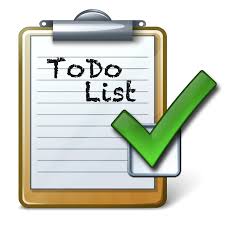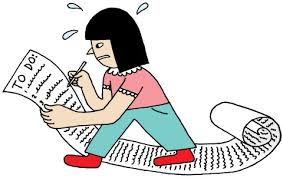ToDo Lists ~ Practical Tips for Dealing with Anxiety

Whether you have a challenging schedule with numerous responsibilities, or you just have difficulty remembering what needs to be done next, consider incorporating a personalized to-do lists into your daily routine. Although incredibly simple, this timeless tool can be a serious sanity saver. Before dealing with anxiety and depression was a major part of my life, I actually had an amazing memory. I could manage a slew of competing responsibilities all in my head. I even credit much of my success in college to my remarkable, somewhat photogenic, memory. So when my recall abilities began a gradual but steady decline, I did what any self-respecting thirty something year old woman would do—I went into complete denial. I hung out with “denial” for several years, which unfortunately resulted in a ton of anxiety, and countless stressful and disappointing consequences (i.e. missed deadlines, forgotten appointments, overdraft fees, etc). This was in addition to my growing sense of incompetence, which was caused by my numerous memory related mishaps.
Eventually I stopped the insane denial routine, and submitted to the fact that I needed help remembering – a lot of help. That’s when I began making and using “to-do lists” on a regular basis. Today my “to-do list” is, by far, the most essential tool I have for organizing and managing my  various obligations. Initially, I would make lists on random pieces of paper, backs of envelopes, Post-It notes, etc. Not surprisingly, I would frequently misplace these lists, or just forget to look at them altogether. As I learned what works best for me, the look and functionality of my to-do lists evolved. I currently use a single journal-style notebook for all my “to-dos”, which eliminates the problems of keeping up with multiple lists. It also dramatically decreases the frequency of me misplacing the list.
various obligations. Initially, I would make lists on random pieces of paper, backs of envelopes, Post-It notes, etc. Not surprisingly, I would frequently misplace these lists, or just forget to look at them altogether. As I learned what works best for me, the look and functionality of my to-do lists evolved. I currently use a single journal-style notebook for all my “to-dos”, which eliminates the problems of keeping up with multiple lists. It also dramatically decreases the frequency of me misplacing the list.
My “to-do list” consists of anything that I need to-do in the future (in a few minutes, few hours, few days, etc). For any given day, my list might include everything from simple tasks like “reply to mom’s email, take vitamins, and defrost chicken”, to more important things like “pay the mortgage and mail the tax return”. Basically, if the task is not already an ingrained part of my routine, I generally write it down. If I’m feeling particularly scattered or rushed, I write down even routine tasks.
Now capturing a constantly evolving to-do list on paper only addresses part of the problem. A system for organizing and prioritizing the tasks is also needed. I tried several systems before settling on one that worked for me. My current strategy is to write the date, and then list all the things that I intend to-do for that particular day. I may star or circle items that have priority, and sometimes I may put a time next to items that are time sensitive. If there are things from the previous day that were left undone, I may add them to today’s list or simply highlight them to draw my attention. When I make progress on a task, I put a check mark next to it. As I complete tasks, I draw a line through them. I can’t tell you how satisfying it is to cross things off my list.
Since using a “to-do list” is now a well-established part of my routine, my daily list tends to be relatively orderly and manageable. However, during particularly stressful or busy periods, I sometimes employ what I call my “brain dump” list. This involves writing down the flood of thoughts, ideas, and tasks racing through my mind, but in no particular order and with no associated dates. The resulting list is generally massive and random, but just having it out of my head brings immediate stress relief. When I’m dealing with anxiety about how and when I can get a ton of things done, a brain dump can be super helpful in deciding where to start. 
To keep my daily to-do list neat and manageable, I capture my brain dump list in a separate place (i.e. the back pages of my journal or in a completely separate notebook). I then review, prioritize, and transfer some of the tasks to my “to-do list” for the day. I might even skip ahead a page or two in my journal, and start adding things for the next couple days. I use that system until I’ve addressed everything from the brain dump list. Having two lists is not ideal, but it is important for me to be able to look at my day and see it as doable. Subsequently, I can clearly see my progress, and avoid getting too anxious or overwhelmed.
Tips
- Be realistic. Don’t pile more on your list than is reasonably possible for you to do in a day. Structure your daily list in such a way that you can see your progress and can have a sense of accomplishment as you move through it.
- Break larger tasks into “bite size” pieces. For example, instead of adding “plan birthday party” to your list, make a list of what needs to be done for the party, and then list the items you plan to tackle for the day individually.
- Keep your list close. Obviously, to get the most benefit out of your to-do list, it must be readily accessible. While at home or work, keeping the list within arms reach will ensure that you can add to and reference it with ease. When on the go, sticking the list in a backpack, purse or briefcase can be very convenient.
- Use attractive, eye-catching journals. When I was initially trying to establish a routine of using a to-do list journal, I realized that the “cuter” the journal, the greater the likelihood that I would remember to use it. Even now when I’m close to filling up one journal, I look forward to going to buying a nice new one.
- Explore your options. Although I’ve found that a journal-style to-do list works best for me, others may prefer to use an app on their smart phone or tablet. How we choose to organize our lists may differ as well. The key is to use what works for you.
 Copyright secured by Digiprove © 2014 Nailah Johnson
Copyright secured by Digiprove © 2014 Nailah Johnson
